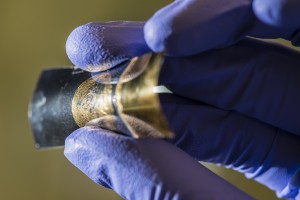 Batteries are a well-known problem for wearable tech. Researchers at Rice University have developed a flexible and rechargeable power resource that bypass batteries entirely in favor of supercapacitors.
Batteries are a well-known problem for wearable tech. Researchers at Rice University have developed a flexible and rechargeable power resource that bypass batteries entirely in favor of supercapacitors.
James Tour, a chemist at Rice, suggests using an electrochemical capacitor a hundredth-of-an-inch thick to store power. The capacitor is easier to build than a battery, Tour says, because it uses only nickel and no lithium. (Lithium has unfortunate reactions with water and is not well-suited for clothing, which needs to be laundered.) The capacitor holds 76 percent of its charge over 10,000 charge-discharge cycles. For the chemistry geeks::
To develop the supercapacitor Tour and his fellow researchers … put a layer of nickel on a backing and then etched it with five-nanometer pores within a layer of nickel fluoride that is 900 nanometers thick. They then removed the backing and sandwiched the electrodes around an electrolyte of potassium hydroxide in polyvinyl alcohol.
Conventional Li-Ion batteries have an energy density of about 165 Wh/kg (watt-hours per kilogram). Tour reports an energy density of 38.4 khW/kg. But Tour also says that the capacitor’s power output is increased by layering the ultra-thin material.
More details in the Journal of the American Chemical Society.